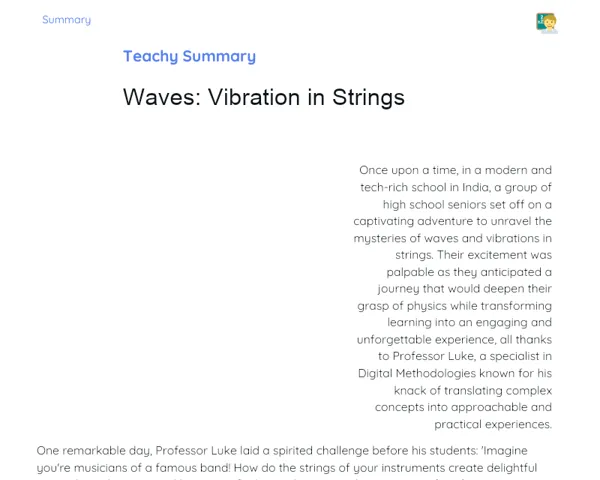Socioemotional Summary Conclusion
Goals
1. 🔍 Grasp the idea of an order of magnitude and see how it finds its use in physics.
2. 📏 Learn to estimate the order of magnitude for various quantities with ease.
3. 🧠 Enhance self-awareness and the knack of making responsible choices.
4. ✨ Sharpen your concentration and mindfulness through guided meditation practices.
Contextualization
Ever wondered how scientists compare things as different as the size of a tiny cell and the vast distance between planets? 🌌✨ The trick lies in the concept of order of magnitude—a brilliant tool that helps simplify the way we understand extremely large or small numbers. Together, we will see how this idea is not only handy in academic subjects but also in daily life, helping us balance our emotions and decisions! 🚀🧘♂️
Exercising Your Knowledge
Definition of Order of Magnitude
Order of magnitude refers to classifying numbers into powers of 10, making it easier to compare figures that differ greatly, like the mass of our Earth and that of a small stone. This method simplifies these comparisons and makes them more intuitive.
-
Classification in powers of 10: Helps in making number comparisons simpler and more visual.
-
Simplicity in comparisons: Enables you to understand how different quantities relate to one another.
-
Wide applicability: Useful in physics, economics, biology and many more areas to grasp scales and impacts.
Calculating the Order of Magnitude
To find the order of magnitude of a number, first identify the nearest power of 10. If the number is closer to 10^n than to 10^(n+1), then its order of magnitude is 10^n. This approach is very practical for quick estimations.
-
Finding the nearest power of 10: Simplifies understanding a number’s scale.
-
Quick approximations: Useful in decision-making when ultra-precision isn’t necessary.
-
Real-life examples: Everyday situations such as measuring distances, durations, or quantities become much easier.
Estimates and Practical Applications
When we make order of magnitude estimates, we are essentially approximating values to handle complex problems in a simple manner. For instance, one could estimate the number of steps taken in a long-distance walk using rough figures. Such approximations are fundamental in physics and other sciences to predict outcomes and design experiments.
-
Hands-on approximations: Vital for solving problems without getting bogged down in exact numbers.
-
Day-to-day examples: Use estimates in everyday life, such as measuring water usage or estimating pulse counts.
-
Importance in sciences: Key to forecasting behaviours and planning methods in experiments and projects.
Key Terms
-
Order of Magnitude: A method to classify numbers in powers of 10 to simplify comparisons.
-
Power of 10: A notation that represents numbers as 10 raised to an exponent.
-
Estimate: A practical approximation based on available data that eases calculations.
For Reflection
-
How might understanding orders of magnitude help you make more informed and responsible decisions in everyday life?
-
In what ways can the knack of making accurate estimates boost your academic and personal experiences?
-
How do practices in meditation and self-awareness contribute to your ability to solve challenging problems?
Important Conclusions
-
🔍 The order of magnitude is an essential tool for simplifying and comparing different quantities, enabling us to better understand our surroundings.
-
📏 Mastering the art of quick estimates paves the way for effective problem-solving in day-to-day situations.
-
🧠 Beyond enhancing scientific knowledge, the skill of estimating fosters self-awareness and encourages responsible decision-making.
Impacts on Society
🎯 In today’s world, being able to understand orders of magnitude is key to making wise decisions. Consider this: when managing natural resources, rough estimates of water, energy, and food consumption can guide effective planning and conservation efforts, contributing to sustainability. 🌍💧🌱 This concept also plays a significant role in fields like economics and public health, where quick, data-driven choices can have life-changing impacts.
💡 On a personal note, knowing how to estimate helps in developing a practical and analytical mindset. Have you ever found yourself deciding whether it’s better to walk or catch an auto to reach your college? 🚌🚶♂️ Being able to roughly gauge distances and durations can simplify your daily commute and improve overall efficiency. This practice not only hones your problem-solving skills but also boosts your confidence and self-esteem. 🌟🙏
Dealing with Emotions
🧘♂️ While diving into the concept of orders of magnitude, it’s natural to feel a mix of emotions. To manage these feelings, we will use the RULER method. Begin by Recognising your emotions when facing a challenging estimation problem — do you feel anxious, curious, or frustrated? 🧩 Next, Understand the reasons behind these feelings. It might be due to the complexity of the problem or the fear of making an error. Clearly naming these emotions, whether you feel challenged or motivated, is the next step. Then, Express your emotions in a healthy way — share your thoughts with a friend or note them down in a journal. Lastly, Regulate your emotions by taking deep breaths, taking short breaks, and celebrating small victories. Together, let’s achieve both academic and emotional well-being! 🚀✨
Study Tips
-
📚 Start with the Basics: Revisit the fundamentals of powers of 10 and understand how they serve in calculating orders of magnitude. This foundation is indispensable for further progress.
-
📝 Practice with Everyday Scenarios: Try making estimates in your daily life. For example, calculate the approximate number of litres of water you use in a week or how long your commute might take. This makes the concept more relatable and practical.
-
🤔 Engage in Discussions: Studying in a group can be very effective. Do estimation exercises with your classmates, share different methods and compare results. This not only reinforces learning but also builds your communication skills.



